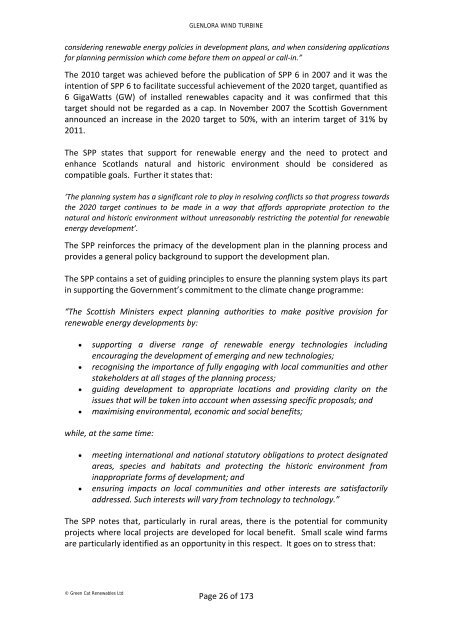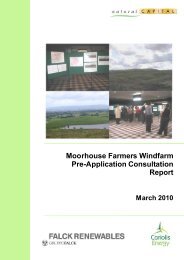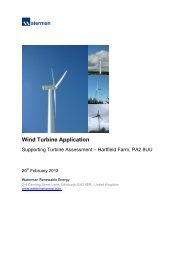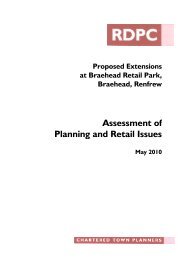Supporting documents - Renfrewshire Council
Supporting documents - Renfrewshire Council
Supporting documents - Renfrewshire Council
Create successful ePaper yourself
Turn your PDF publications into a flip-book with our unique Google optimized e-Paper software.
© Green Cat Renewables Ltd<br />
GLENLORA WIND TURBINE<br />
considering renewable energy policies in development plans, and when considering applications<br />
for planning permission which come before them on appeal or call‐in.”<br />
The 2010 target was achieved before the publication of SPP 6 in 2007 and it was the<br />
intention of SPP 6 to facilitate successful achievement of the 2020 target, quantified as<br />
6 GigaWatts (GW) of installed renewables capacity and it was confirmed that this<br />
target should not be regarded as a cap. In November 2007 the Scottish Government<br />
announced an increase in the 2020 target to 50%, with an interim target of 31% by<br />
2011.<br />
The SPP states that support for renewable energy and the need to protect and<br />
enhance Scotlands natural and historic environment should be considered as<br />
compatible goals. Further it states that:<br />
‘The planning system has a significant role to play in resolving conflicts so that progress towards<br />
the 2020 target continues to be made in a way that affords appropriate protection to the<br />
natural and historic environment without unreasonably restricting the potential for renewable<br />
energy development’.<br />
The SPP reinforces the primacy of the development plan in the planning process and<br />
provides a general policy background to support the development plan.<br />
The SPP contains a set of guiding principles to ensure the planning system plays its part<br />
in supporting the Government’s commitment to the climate change programme:<br />
“The Scottish Ministers expect planning authorities to make positive provision for<br />
renewable energy developments by:<br />
supporting a diverse range of renewable energy technologies including<br />
encouraging the development of emerging and new technologies;<br />
recognising the importance of fully engaging with local communities and other<br />
stakeholders at all stages of the planning process;<br />
guiding development to appropriate locations and providing clarity on the<br />
issues that will be taken into account when assessing specific proposals; and<br />
maximising environmental, economic and social benefits;<br />
while, at the same time:<br />
meeting international and national statutory obligations to protect designated<br />
areas, species and habitats and protecting the historic environment from<br />
inappropriate forms of development; and<br />
ensuring impacts on local communities and other interests are satisfactorily<br />
addressed. Such interests will vary from technology to technology.”<br />
The SPP notes that, particularly in rural areas, there is the potential for community<br />
projects where local projects are developed for local benefit. Small scale wind farms<br />
are particularly identified as an opportunity in this respect. It goes on to stress that:<br />
Page 26 of 173

















